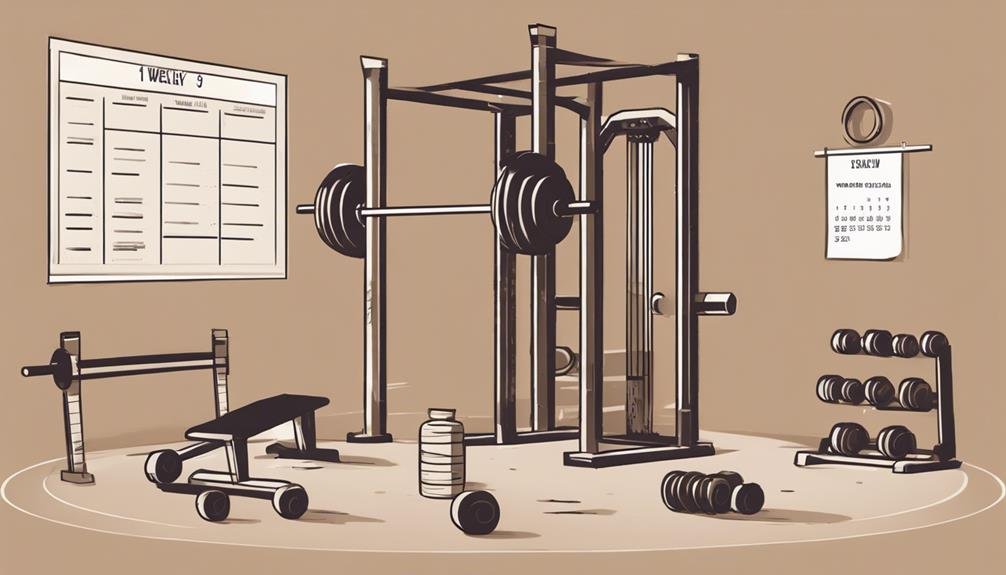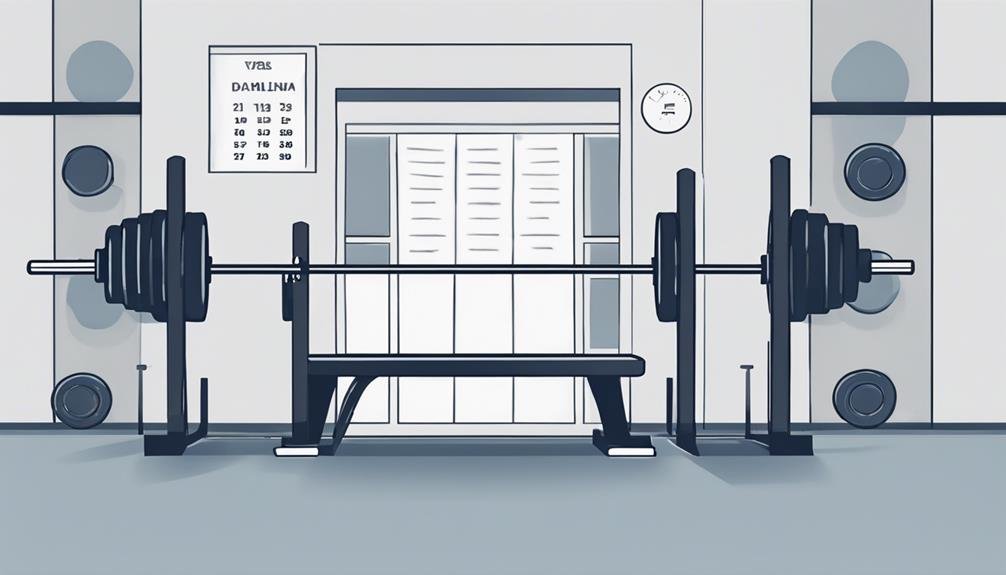Essential Weightlifting Routines for Men Over 40
Weightlifting is essential for men over 40, helping you maintain muscle mass and boost your metabolism. Focus on classic compound exercises like squats, deadlifts, bench presses, and pull-ups. A sample weekly routine could include full-body workouts on Monday, upper body on Wednesday, and lower body on Friday. Always start with a thorough warm-up and allow for recovery. Prioritize proper form and incorporate flexibility exercises to support joint health. Keep track of your progress and set realistic goals to stay motivated. Discover the detailed strategies and tips that can enhance your lifting experience even further.
Key Takeaways
- Prioritize compound exercises like squats, deadlifts, and bench presses to build overall strength efficiently.
- Incorporate flexibility and mobility exercises to enhance joint health and maintain range of motion.
- Emphasize proper form and lighter weights to prevent injuries, especially for sensitive joints.
- Schedule rest and recovery days to allow muscles to heal and grow stronger post-workout.
Benefits of Weightlifting After 40
Weightlifting after 40 boosts your strength, enhances your metabolism, and helps maintain overall health as you age. As you incorporate resistance training into your routine, you'll notice improvements in muscle mass, which naturally declines with age. This increase in muscle not only makes daily activities easier but also supports joint health and stability.
Moreover, lifting weights can considerably elevate your metabolism, helping you burn more calories even at rest. You'll likely find it easier to manage your weight, reducing the risk of chronic diseases.
Engaging in weightlifting also promotes mental well-being by releasing endorphins, which can improve your mood and reduce stress. Ultimately, committing to a weightlifting regimen empowers you to lead a healthier, more active lifestyle as you grow older.
Key Considerations for Older Lifters

As you approach weightlifting in your 40s and beyond, it's crucial to prioritize safety and listen to your body's signals.
Start with a thorough warm-up to prepare your muscles and joints, reducing the risk of injury.
Focus on proper form over heavy weights; it's better to lift lighter correctly than to struggle with heavier loads.
Pay attention to recovery time; your body may need longer to heal after workouts.
Incorporate flexibility and mobility exercises into your routine to maintain range of motion.
Don't hesitate to consult a fitness professional if you're unsure about techniques or routines.
Classic Compound Exercises
Incorporating classic compound exercises into your routine can greatly enhance strength and muscle mass while promoting functional fitness for daily activities. These movements engage multiple muscle groups, making them efficient and effective.
Here are four essential exercises to include:
- Squats – Build lower body strength and improve mobility.
- Deadlifts – Target the back, glutes, and hamstrings, promoting overall stability.
- Bench Press – Strengthen your chest, shoulders, and triceps, enhancing upper body power.
- Pull-Ups – Develop your back, biceps, and grip strength, vital for various activities.
Sample Weekly Weightlifting Schedule

Creating a balanced weekly weightlifting schedule is essential for maximizing your strength gains while allowing for proper recovery.
Start your week with a Monday full-body workout, focusing on compound exercises like squats and bench presses.
On Tuesday, prioritize cardio or active recovery.
Wednesday should be dedicated to upper body strength, incorporating rows and shoulder presses.
Thursday is another recovery day; consider light stretching or yoga.
On Friday, hit your lower body again with deadlifts and lunges, and wrap up the week on Saturday with a mix of core-focused exercises.
Finally, take Sunday off to rest.
Adjust the intensity and volume based on how your body feels, ensuring you listen to your needs while staying consistent.
Importance of Warm-Up and Cool-Down
Proper warm-up and cool-down routines are essential for enhancing your performance and reducing the risk of injury during weightlifting sessions. When you take the time to prepare your body, you set yourself up for success.
Here's what you should focus on:
- Dynamic stretches: Activate your muscles and increase blood flow.
- Light cardio: Get your heart rate up to improve circulation.
- Specific muscle activation: Target muscles you'll use in your workout to guarantee they're ready.
- Static stretching: Post-workout, help your muscles relax and recover.
Incorporating these elements into your routine can greatly impact your strength training journey. Don't skip them; your body will thank you!
Modifications for Joint Health

To protect your joints while weightlifting, consider making modifications to your routine that prioritize joint health and overall mobility.
Start by incorporating low-impact exercises, such as resistance bands or bodyweight movements, which can reduce strain on your joints.
Focus on form over weight; using lighter weights with proper technique can help prevent injuries.
Avoid exercises that involve deep squats or heavy overhead lifts, as these can stress your joints. Instead, opt for partial ranges of motion or substitute with machines that provide support.
Additionally, include flexibility and mobility work, like stretching or yoga, to enhance joint stability.
Listen to your body, and if something feels off, don't hesitate to adjust your routine to keep your joints healthy and functional.
Nutrition Tips for Muscle Recovery

Focusing on nutrition is just as important as modifying your workout for joint health, as it plays a vital role in muscle recovery after weightlifting. To guarantee your muscles recover efficiently, keep these tips in mind:
- Protein Power: Include lean proteins like chicken, fish, or legumes in your post-workout meal to help repair muscle fibers.
- Hydration: Drink plenty of water to flush out toxins and keep your muscles hydrated.
- Healthy Fats: Incorporate sources like avocados or nuts, which help reduce inflammation and promote recovery.
- Carb Timing: Consume complex carbohydrates, such as sweet potatoes or whole grains, within two hours after your workout to replenish glycogen stores.
Tracking Progress Safely

Tracking your progress safely is essential for preventing injuries and ensuring that your weightlifting routine remains effective as you age.
Start by keeping a detailed log of your workouts, including weights, sets, reps, and how you felt during each session. This not only helps you see your progress but also highlights any potential issues.
Listen to your body; if you notice persistent soreness or fatigue, it might be time to adjust your routine.
Use a reliable method to evaluate your form, like filming your lifts or working with a trainer.
Incorporating Flexibility Training

Incorporating flexibility training into your routine can greatly enhance your overall performance and help prevent injuries as you age. It's crucial to make stretching a regular part of your weightlifting regimen.
Here are four key benefits you can enjoy:
- Improved Range of Motion: Stretching helps your joints move more freely, allowing for better lifting form.
- Reduced Muscle Tension: Regular flexibility work can alleviate tightness, enhancing your recovery.
- Enhanced Blood Circulation: Increased blood flow to your muscles aids in nutrient delivery and promotes healing.
- Better Posture: Flexibility training can help correct imbalances, supporting a strong and healthy stance during lifts.
Staying Motivated and Consistent

Staying motivated and consistent in your weightlifting routine is key to achieving long-term strength and health, especially as you navigate your 40s and beyond.
To keep your motivation high, set realistic goals and track your progress regularly. Celebrate small victories, whether it's lifting heavier weights or completing a workout consistently.
Mix up your routine to prevent boredom; try new exercises or join a class. Finding a workout buddy can also boost your commitment, as you'll hold each other accountable.
Schedule your workouts just like any important appointment, and don't skip them. Finally, remember why you started—focus on the benefits, like increased energy and improved overall well-being.
Stay dedicated, and you'll see the results you desire.
Questions
How Do I Choose the Right Weight for My Workouts?
To choose the right weight, start with a weight you can lift comfortably for 8-12 reps. Gradually increase it as you gain strength, ensuring you maintain proper form without straining or risking injury.
What Types of Equipment Should I Invest in for Home Workouts?
Imagine transforming your garage into a personal gym. Invest in adjustable dumbbells, resistance bands, and a sturdy bench. These versatile tools will empower your workouts, ensuring you stay strong and motivated without stepping outside.
How Can I Prevent Injuries While Weightlifting?
To prevent injuries while weightlifting, always warm up properly, use correct form, and start with lighter weights. Listen to your body, take rest days, and gradually increase intensity to guarantee safe, effective workouts.
Are There Specific Supplements Recommended for Older Lifters?
Like a wise old oak, you might consider supplements like vitamin D, omega-3s, and collagen. They can support joint health and recovery, helping you lift effectively while minimizing the wear and tear on your body.
How Do I Know if My Form Is Correct?
To guarantee your form's correct, use a mirror or record yourself lifting. Compare your posture to instructional videos, and consider asking a knowledgeable friend or trainer for feedback. Regularly assess and adjust your technique as needed.
Conclusion
Incorporating weightlifting into your routine after 40 can greatly boost your health and vitality.
Research shows that men who engage in regular strength training can reduce their risk of chronic diseases by up to 40%.
By focusing on classic compound exercises and maintaining consistency, you'll not only enhance muscle strength but also improve your overall quality of life.
Remember, it's never too late to start; your body will thank you for the effort you put in!







